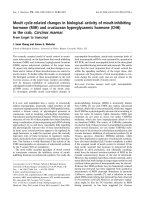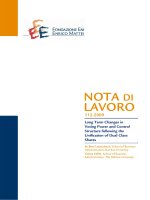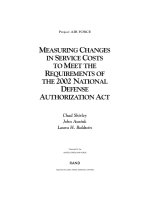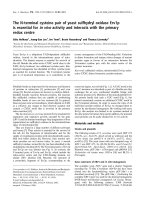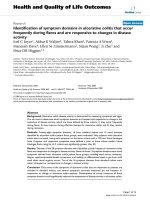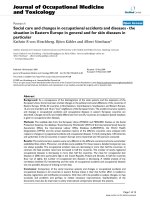Changes in α–galactosidase activity and oligosaccharides during germination of soybean seeds
Bạn đang xem bản rút gọn của tài liệu. Xem và tải ngay bản đầy đủ của tài liệu tại đây (648.32 KB, 8 trang )
<span class='text_page_counter'>(1)</span><div class='page_container' data-page=1>
<i>DOI:10.22144/ctu.jsi.2018.089 </i>
<b>Changes in α-galactosidase activity and oligosaccharides during germination of </b>
<i><b>soybean seeds </b></i>
Duong Thi Phuong Lien
1*<sub>, Phan Thi Bich Tram</sub>
1<sub>, Trang Si Trung</sub>
2<sub> and Ha Thanh Toan</sub>
3<i>1<b><sub>College of Agriculture and Applied Biology, Cantho University, Vietnam </sub></b></i>
<i>2<b><sub>Faculty of Food Technology, Nha Trang University, Vietnam </sub></b></i>
<i>3<b><sub>Biotechnology Research and Development Institute, Cantho University, Vietnam </sub></b></i>
<i>*<b><sub>Correspondence: Duong Thi Phuong Lien (email: ) </sub></b></i>
<b>ARTICLE INFO </b> <b> ABSTRACT </b>
<i>Received 23 May 2018 </i>
<i>Revised 15 Jun 2018 </i>
<i>Accepted 03 Aug 2018 </i>
<i><b> The effect of germination process on α–galactosidase activities, </b></i>
<i>oligosac-charides and reducing sugars contents in soybean seeds was investigated. </i>
<i>Soaked soybean seeds were germinated at 25o<sub>C in dark condition for 72 </sub></i>
<i>hours. Samples were collected every 12 hours during germination for </i>
<i>an-alyzing the α–galactosidase activities, which was monitored with a </i>
<i>syn-thetic substrate ρ-nitrophenyl-α-D-galactopyranoside (ρNPGal). The </i>
<i>freeze-dried samples were prepared for determination of raffinose, </i>
<i>stach-yose, sucrose by thin layer chromatography, and reducing sugars were </i>
<i>as-sayed by reaction with nitro salicylic acid. After soaking, the activity of α–</i>
<i>galactosidase increased1.84 times compared to that in the soybean seeds </i>
<i>and reached maximum value (164.3±2.5 U/100g, db) after 12 hours of </i>
<i>ger-mination. The increase in α–galactosidase activity led to the decrease in </i>
<i>raffinose and stachyose contents during soaking and germination. In </i>
<i>addi-tion, the degradation of these undesirable components followed the first </i>
<i>order exponential equation (R2 <sub>= 0.97–0.99). Sucrose content remained </sub></i>
<i>af-ter soaking and up to 12 hours of germination and reduced significantly </i>
<i>after that. The final result of the hydrolysis of raffinose, stachyose and </i>
<i>su-crose was significant increase in reducing sugars that can be used as </i>
<i>en-ergy-source during germination of soybean seeds. </i>
<i><b>KEYWORDS </b></i>
<i>α–galactosidase, </i>
<i>germina-tion, oligosaccharides, </i>
<i>soy-beans, thin layer </i>
<i><b>chromatog-raphy </b></i>
Cited as: Lien, D.T.P., Tram, P.T.B., Trung, T.S. and Toan, H.T., 2018. Changes in α–galactosidase activity
and oligosaccharides during germination of soybean seeds. Can Tho University Journal of Science.
<i>54(Special issue: Agriculture): 8-15. </i>
<b>1 INTRODUCTION </b>
<i>Soybean (Glycine Max. (L.) Merril) is an excellent </i>
source of proteins for human consumption.
How-ever, direct utilization of soybeans is undesirable
due to its indigestible oligosaccharides content
which may induce flatulence in humanity (Reddy
<i>and Salunkhe, 1980; Alani el al., 1990; Wang el al., </i>
2007). The indigestible oligosaccharides in soybean
seeds are a group of soluble low molecular weight,
mainly raffinose [α–D–galactopyranosyl–(1,6)–α–
D–glucopyranosyl–β–D–fructofuranoside] and
stachyose[α–D–galactopyranosyl–(1,6)–α–D–ga-lactopyranosyl–(1,6)–α–D–glucopyranosyl–β–D–
<i>fructofuranoside] (Guimarães el al., 2001; Wang el </i>
<i>al., 2007). Since humans gastrointestinal tract lacks </i>
the enzyme α–galactosidases (E.C. 3.2.1.22, α–D–
galactosidegalactohydrolase) being necessary for
the hydrolysis of the α–1,6 linkages present in
oli-gosaccharides (Reddy and Salunkhe, 1980), these
components pass intactly into the large intestine
where the fermentation of anaerobic
<i>microorgan-isms occurs, then causing flatulence (Guimarães el </i>
</div>
<span class='text_page_counter'>(2)</span><div class='page_container' data-page=2>
Various processing methods can reduce the
flatu-lence of soybeans inducing seed germination
<i>(Markakis, 1987; Alani el al., 1990), cooking (Oboh </i>
<i>el al., 2000; Ramadan, 2012), ethanol and aqueous </i>
<i>extraction (Rackis el al., 1970; Omosaiye el al., </i>
1978) and fermentation (Akinyele and Akinlosotu,
1991; Egounlety and Aworh, 2003). Among them,
germination is a relatively simple and inexpensive
<i>one that produces a natural type of food (Shah el al., </i>
2011). Germination causes marked metabolic
changes in the seeds resulting in the
susceptiblydegradation of carbohydrates (Rackis,
1981; Nnanna and Phillips, 1988). The
α–galacto-sidases were suspected to play an important role in
the early stages of germination by hydrolyzing
ga-lactose-containing oligosaccharides to provide
<i>me-tabolites for the developing seedling (Dey el al., </i>
1986; Dey and Campillo, 2006), and thereby the
ol-igosaccharides contents were reduced.
This study on changes in α–galactosidase activity
and oligosaccharide content during the germination
of soybean seeds is to provide practical
recommen-dations for reducing the flatus activity in soybeans.
<b>2 MATERIALS AND METHODS </b>
<b>2.1 Chemicals </b>
The standard raffinose, stachyose and sucrose were
purchased from Merck Company (Germany). The
synthetic substrate ρNPGal was from
Sigma-Al-drich.
<b>2.2 Soybeans and germination process </b>
Soybeans (MTD 760 variety) were supplied from
Department of Genetics and Plant Breeding,College
of Agriculture and Applied Biology, Can Tho
Uni-versity. The seeds were cleaned and rinsed with
clean water before being soaked for 12 hours to
reach the equilibrium moisture content at ambient
temperature. Soaking process was carried out in
drinkable water with the ratio of soybean seeds and
water of 1: 5 and the concentration of gibberellic
acid in soaking water of 1 mg/L. The soaked beans
were drained, rinsed and placed in a germination
chamber in dark condition. Watering the seeds was
set up two minutes every 4 hours with clean water
automatically. The germination process was carried
out at 25o<sub>C for 0, 12, 24, 36, 48, 60 and 72 hours </sub>
<i>(Duong el al., 2016). α–galactosidases activities </i>
were determined in fresh germinated soybeans, and
and kept on orbital shaker at 130 rpm for 16 hours.
The contents of the flask were filtered through
Whatman No.1 filter paper, and the residue was
fur-ther washed with 5mL of 70% ethanol. The filtrate
was evaporated in a rotary vacuum evaporator at
45ºC. The syrup was dissolved in 2 mL of distilled
<i>water (Tajoddin el al., 2010a). </i>
<i>TLC of oligosaccharides: Assay of oligosaccharides </i>
by TLC was carried out following the method of
<i>Tanaka el al. (1975)and Tajoddin el al. (2010a) with </i>
some modifications. Six microliters of syrup were
applied on chromatographic plates (20 cm × 20 cm)
coated with microcrystalline cellulose powder.
Spotting of the sugar samples was done by using
ca-pillary tubes. Each sample was spotted thrice
sepa-rately (2 µL for each spotting) and dried. Plates were
developed using solvent system
n-propa-nol:ethylacetate:water (6:1:3). The developed plates
were sprayed with 1% α-naphthol in alcohol 95% to
locate the sugars spots. For quantitative
determina-tion of the amounts of sucrose, raffinose and
stach-yose, a sugar spot on a chromatogram was scraped
off, and the sugar was extracted with 4 mL of
dis-tilled water in a test tube overnight at room
temper-ature. One mL of eluent was mixed with 1 mL of
0.02M thiobarbituric acid and 1 mL of concentrated
hydrochloric acid. The mixture was heated in a
boil-ing water bath for exactly 6 min, then cooled under
running water(Percheron, 1962). The yellow color
produced was read at 432.5 nm. The concentration
of sugar was calculated from working standards.
<b>2.4 Determination of reducing sugar </b>
The estimation of the reducing water was carried out
by nitro salicylic acid reagent (2% NaOH and 20%
sodium potassium tartrate). In the estimation, the
sample (1 g) was extracted with hot water (70–
80o<sub>C), filtered and mixed with nitro salicylic acid </sub>
reagent in a boiling water bath for 10 minutes. Color
intensity was measured at 540 nm, using a standard
<i>curve of glucose (Mao el al., 2013). The results were </i>
expressed as percent in dry weight (%, db).
</div>
<span class='text_page_counter'>(3)</span><div class='page_container' data-page=3>
di-at 37o<sub>C and stopped by the addition of 1 mL of 0.5 </sub>
M sodium carbonate. The yellow color produced
was measured at wavelength of 420nm. Control
sample involved adding enzyme extracts after the
sodium carbonate solution had been added. The
con-trol was used as the zero calibration reading. The
molar extinction coefficient for ρ–nitrophenol was
taken as 18,400 (Reid and Meier, 1973) to calculate
the amount of ρ–nitrophenol released. A unit of
en-zyme activity (U) was defined as the amount of
α-galactosidase which liberates 1 µmol of
ρ–ni-trophenol per min under the given assay conditions
<i>(Rezende el al., 2005). The results were as U/100 g </i>
sample on dry weight.
<b>2.6 Data analysis </b>
All data were performed in triplicate and were
sub-mitted to analysis of variance (ANOVA) by
Porta-ble Statgraphics Centurion 15.2.11.0. The
regres-sion analysis was carried out by Microsoft Excel
2007.
<b>3 RESULTS AND DISCUSSION </b>
Germination begins with the water uptake of dry
seed, and ends with the emergence of the radicle
(Bewley, 1997).The images of soybean seed during
germination were illustrated in Figure 1. According
<i>to Han el al. (2013), the first stage of germination is </i>
a rapid water uptake phase (about 12 hours after
soaking), the second stage is a plateau phase and for
soybean seeds germination, plateau phase was
de-fined as 12–24 hours after imbibition. The last phase
is the post-germination stage in which the radicle
begins to grow (Figure 1).
<b>Figure 1: Images of soybean seeds during germination </b>
Figure 2 showed the TLC results depicting the
sep-aration pattern of standard sugars and
oligosaccha-rides of soybean seed and germinated soybeans. The
identity of sucrose, raffinose and stachyose in
soy-bean samples was confirmed by spots of the
corre-sponding standard sugars (Figure 2A). The spots in
Figure 2B are the oligosaccharides of soybean
sam-ples. The change of the contents of raffinose,
stach-yose, sucrose and reducing sugars of soybeans after
soaking and during germination were shown in
Ta-ble 1. It is doubted that α–galactosidasein seeds
in-volved in the hydrolysis galactose-containing
oligo-saccharides leading to the change in oligosaccharide
<i>content (Dey el al., 1986; Dey and Campillo, 2006). </i>
Therefore, the activity of α–galactosidase in
soy-bean seeds and germinated soysoy-beans were
deter-mined and shown in Table 1.
</div>
<span class='text_page_counter'>(4)</span><div class='page_container' data-page=4>
<b>Figure 2: TLC analysis of standard oligosaccharides (A) and soybean samples (B) </b>
Table 1 showed that the raffinose and stachyose
level in the soybeans were 1.05±0.07 and
4.75±0.09%, respectively. This is in agreement with
the previous study which reported that the raffinose
and stachyose contents were 0.99 and 4.87% in
<i>soy-bean seeds (Abdullah el al., 1984). The sucrose </i>
con-tent of soybean seeds was 5.96±0.08% (Table 1) and
was in range of 2.69–8.63% that resulted from the
study on the sucrose content of 14 soybean
<i>geno-types (Teixeira el al., 2012). Other authors found </i>
that the ranges of raffinose, stachyose and sucrose
of three soybean cultivars were 0.75–1.16, 3.28–
<i>4.09 and 3.97–4.81%, respectively (Silva el al., </i>
1990).
<b>Table 1: Changes in sugars contents and α-galactosidase activity during germination of soybeans </b>
<b>Germination </b>
<b>time (hours) </b> <b>Raffinose (%) Stachyose (%) </b> <b>Sucrose (%) </b>
<b>Reducing sugar </b>
<b>(%) </b>
<b>α-galactosidase </b>
<b>activ-ity (U/100 g) </b>
Soybeans
0 (soaked)
12
24
36
48
60
72
1.05±0.07a
0.95±0.02b
0.86±0.02c
0.66±0.02d
0.44±0.02e
0.34±0.02f
0.27±0.01g
0.21±0.01g
4.75±0.09a
4.45±0.09b
3.78±0.04c
3.14±0.03d
2.53±0.02e
1.99±0.01f
1.55±0.04g
1.15±0.02h
5.96±0.08a
5.79±0.08a
5.77±0.06a
5.16±0.07b
2.67±0.09c
2.47±0.06c
2.35±0.07c
2.34±0.04c
2.50±0.18f
2.41±0.18f
3.14±0.09e
3.45±0.10e
5.93±0.17c
6.32±0.13b
7.88±0.14a
5.22±0.14d
47.8±1.1f
87.9±1.1bc
164.3±2.5a
93.8±7.1b
84.2±2.1cd
85.2±6.3cd
74.5±4.4e
78.1±2.8de
<i>Data are expressed as mean ± standard deviation (with n=3). In a column, values followed by the same letter are not </i>
<i>significantly different (p< 0.05) by LSD test. </i>
The activity of α-galactosidase was detected in the
seeds even before imbibitions, suggesting that this
enzyme is pre-existing and present in the ripe seeds
<i>(Lahuta el al., 2000; Ataíde el al., 2013). In the </i>
pre-sent study, the α-galactosidase activity was 47.8±1.1
U/100g. The α-galactosidase activity was found 36
stachyose contents decreased after soaking. The
per-cent of loss of raffinose and stachyose after soaking
were 9.2 and 6.4%, respectively. The losses of
raffi-nose and stachyose in the soaking water were
repre-sented 3.32 and 0.37% of these contents in starting
<i>soybeans (Wang el al., 2007). However, according </i>
to other result, up to 56.3% of oligosaccharides in
<b>Soybean 0 hr 12 hrs 24 hr 36 hr 48 hr 60 hr 72 hr</b>
<b>seeds (soaked) </b>
<b>B</b>
<b>Stachyose Raffinose Sucrose</b>
</div>
<span class='text_page_counter'>(5)</span><div class='page_container' data-page=5>
Another reason for the reduction in oligosaccharide
content after soaking of soybeans may be leaching
of oligosaccharides into soaking water. When
soy-bean is soaked, the water is absorbed into the soy-bean,
the oligosaccharides dissolved and leached into the
surrounding water (Han and Baik, 2006;
<i>Agbenorhevi el al., 2007). </i>
The statistical results from Table 1 and the spots in
Figure 2B demonstrated that raffinose and stachyose
contents of soybeans significantly decreased (p <
0.05) during germination. As the period of
germina-tion was prolonged, significant and successive
re-duction in oligosaccharides was observed. Highest
loss of raffinose and stachyose was observed in
soy-beans respectively after 72 hours of germination,
which was corresponding to 79.6 and 75.8%.
Di-minishing effect of germination on raffinose and
stachyose has been noticed for black gram, mung
bean, cowpeas and other legume seeds (Reddy and
<i>Salunkhe, 1980; Alani el al., 1990; Oboh el al., </i>
<i>2000; Tajoddin el al., 2010a). During germination, </i>
raffinose and stachyose levels decreased in all three
soybean cultivars, and it was possible to measure
small amounts of these oligosaccharides after six
<i>days of germination (Silva el al., 1990). In other </i>
studieson soybean germination, raffinose was
<i>con-cluded to disappearon the fourth day (East el al., </i>
1972) and on the third day (Chen and Luh, 1976),
and stachyose was found to disappear on the sixth
<i>day (East el al., 1972) and on the fourth day (Chen </i>
and Luh, 1976). The wide variance in the findings
may be due to differences in type of bean, conditions
of germination or activity of enzymes, particularly
<i>α-galactosidase (Abdullah el al., 1984). The </i>
in-crease in α-galactosidase activity in soybeans during
early stage of germination in the present study was
able to explain the degradation of indigestible
oligo-saccharides. The highest activity of α-galactosidase
in germinated soybeans was 164.3±2.5 U/100g
cor-responding to the 12-hour germination. After that, it
reduced significantly, however, the activity of
α-ga-lactosidase in soybeans after 72 hours of
germina-tion was still significantly higher than that of
soy-bean seeds (Table 1). The observed rule of
α-galac-tosidase activity change during germination is
<i>simi-lar to that of cowpeas (Agbenorhevi el al., 2007), </i>
<i>rosewood seeds (Carrijo el al., 2010)and black gram </i>
seeds(Reddy and Salunkhe, 1980). The
α-galacto-sidase catalyzed the hydrolytic removal of α–1,6–
linked–galactose residues from simple
oligosaccha-rides including stachyose and raffinose forming
su-crose that can be further hydrolyzed to obtain
<i>glu-cose and fructose (Zhang el al., 2015). The </i>
break-down of oligosaccharides by active α-galactosidases
in seeds took place during germination and even
<i>soaking stage before germination (Blöchl el al., </i>
<i>2008; Tajoddin el al., 2010a). The above </i>
mecha-nism of reaction and the rule of α-galactosidases
ac-tivity change explained why the sucrose content
re-mained high and unchanged after soaking and in the
early stages of germination (12 hours from
begin-ning), after that the sucrose content decreased
sig-nificantly (Table 1 and Figure 2B). Sucrose content
in barley was unchanged during first 2 day
germi-nation, but it diminishes markedly after 3 days
<i>(MacLeod el al., 1953). Some authors reported an </i>
increase in sucrose content during the first stage of
germination in black gram (Reddy and Salunkhe,
<i>1980) and mung beans (Tajoddin el al., 2010a). </i>
<i>Alaniel al. (1990) stated that sucrose content in </i>
cow-peas declined during the first 6 hours of
germina-tion, then increased after 24 hours of germination
<i>(Alani el al., 1990). The alteration in sucrose content </i>
during germination was the result from the
follow-ing events: the hydrolysis of raffinose and stachyose
forming sucrose by α-galactosidase enzyme; the
hy-drolysis further of sucrose forming glucose and
fructose used as energy-source for the projection of
the radicles and promote development of seedlings
(Sett, 2016). In the first stage, the α–galactosidase
activity and content of oligosaccharides were high,
so the hydrolysis of oligosaccharides to form
su-crose predominated that resulted in high content of
sucrose. After this stage, oligosaccharides content
decreased the hydrolysis of sucrose to form glucose,
and fructose became remarkable. The hydrolysis of
oligosaccharides as well as sucrose led to increase
in reducing sugars during germination. The
reduc-ing sugars content in soybeans was highest after 72
hours of germination, which increased 2.1 times
compared to that of soybean seeds (Table 1). This
was similar to results reported for fenugreek seeds
during 96 hours of germination (El‐Mahdy and El‐
Sebaiy, 1983).
Germination reduced indigestible oligosaccharides
contents in soybeans, and there is a positive
correla-tion between the decline in oligosaccharides
<i>con-tents and the depression of seed longevity (Górecki </i>
<i>el al., 2001). Evaluation the degradation efficiency </i>
of indigestible oligosaccharides during germination
is important for estimation of the changes their
con-tentsand the rate of reaction. These changes can be
described by the application of the following zero
order (Eq. I), first order (Eq. II) orsecond order (Eq.
<i>III) equations(Kadlec el al., 2008). </i>
C = Co – kt (Eq. I)
C = Coexp(–kt) (Eq. II)
1/C =1/Co+ kt (Eq. III)
</div>
<span class='text_page_counter'>(6)</span><div class='page_container' data-page=6>
<b>Table 2: Correlation coefficients calculated for the equations applied to oligosaccharides degradation </b>
<b>during soybean germination </b>
<b>Raffinose </b> <b>Stachyose </b>
<b>Eq. </b> <b>Models </b> <b>R2<sub> Eq. Models </sub></b> <b><sub>R</sub>2</b>
(I)
(II)
(III)
C = 0.93434 – 0.01123 × t
C = 1.04 exp(–0.02284 × t)
1/C = 0.585 + 0.0543 × t
0.95
0.97
0.93
(I)
(II)
(III)
C = 4.312 – 0.0462 × t
C = 4.74 exp(–0.0188 × t)
1/C = 0.151 + 0.0086 × t
0.99
0.99
0.92
Table 2 showed the correlation coefficients (R2<sub>) </sub>
cal-culated using all equations. In case of raffinose, the
best approximation (R2<sub> = 0.97) was achieved using </sub>
Eq. II, and the fitted models used for estimation
stachyose content were Eq. 1 and Eq. 2 (R2<sub> = 0.99). </sub>
The changes in total oligosaccharides content with
germination time for mung bean and lentil were
sim-ulated by Eq. I (R2<sub> = 0.96 and 0.95, respectively) </sub>
and for chickpea by Eq. II (R2<i><sub> = 0.97)(Kadlec el al., </sub></i>
2008). In the present study, there was not any model
that could be stimulated the changes in sucrose and
reducing sugar contents as well as α–galactosidase
activity with germination time. Besides, there was
no relationship between α–galactosidase activity
and oligosaccharides contents.
<b>4 CONCLUSIONS </b>
Germination causes significant decreases in
indi-gestible oligosaccharides. This desirable change is
mostly due to the action of α–galactosidase in
soy-bean seeds which was activated during soaking and
germinating. The first order equation was the best
approximation for the degradation of both raffinose
and stachyoseduring soybean germination. The
hy-drolysis of undigestible oligosaccharides leading to
increase in reducing sugars was used as
energy-source for the development of seedlings. Reduction
of these undesirable components by germination
promises an effective method for reducing both
fla-tus-causing factors and antinutrients in soybeans.
Germination is one of the most promising methods
for reducing flatus-causing factors and improving
nutritional value for soybeans.
<b>ACKNOWLEDGMENTS </b>
We are thankful for VLIR–NETWORK Project for
the partly financial support forthis research.
<b>REFERENCES </b>
Abdullah, A., Baldwin, R. E. and Minor, H., 1984.
Ger-mination effects on flatus-causing factors and
antinu-Akinyele, I. O. and Akinlosotu, A., 1991. Effect of
soak-ing, dehulling and fermentation on the
<i>oligosaccha-rides and nutrient content of cowpeas (Vigna </i>
<i>unguic-ulata). Food Chemistry. 41(1): 43-53. </i>
Alani, S. R., Smith, D. M. and Markakis, P., 1990.
Changes in alpha-galactosidase activity and
oligosac-charides during germination and incubation of
<i>cow-peas (Vigna unguiculata). Food Chemistry. 38(2): </i>
153-158.
Ataíde, G. d. M., Gonỗalves, J. F. d. C., Guimaróes, V.
M., Bicalho, E. M. and Flores, A. V., 2013.
Activi-ties of α-galactosidase and polygalacturonase during
<i>hydration of Dalbergia nigra ((Vell.) Fr All. ex </i>
<i>Benth.) seeds at different temperatures. Journal of </i>
Seed Science. 35(1): 92-98.
Bewley, J. D., 1997. Seed germination and dormancy.
The Plant Cell. 9(7): 1055-1066.
Blöchl, A., Peterbauer, T., Hofmann, J. and Richter, A.,
2008. Enzymatic breakdown of raffinose
oligosac-charides in pea seeds. Planta. 228(1): 99-110.
Carrijo, L. C., Borges, E. E. d. L., Pontes, C. A., Lopes,
M. R. and Brune, A., 2010. α-galactosidase activity
<i>and carbohydrate mobilization in seeds of Dalbergia </i>
<i>nigra (vell.) Allemão ex Benth.-fabaceae (Brazilian </i>
<i>rosewood) during germination. Cerne. 16(3): 283-289. </i>
Chen, A. O. and Luh, B. S., 1976. Oligosaccharides and
nutrients in soybean sprouts. Food Science. 3: 13-25.
Dey, P. M., Naik, S. and Pridham, J. B., 1986. Further
characterization of α-galactosidase I-glycoprotein
lectin from Vicia faba seeds. Phytochemistry. 25(5):
1035-1041.
Dey, P. M. and Campillo, E. D., 2006. Biochemistry of
the multiple forms of glycosidases in plants.
Ad-vances in Enzymology and Related Areas of
Molecu-lar Biology. 56: 141-249.
Duong, T. P. L., Tran, M. P., Phan, T. B. T. and Ha, T.
T., 2016. Time and temperature dependence of
<i>anti-oxidant activity from soybean seeds (Glycine max L. </i>
<i>Merr.) during germination. International Journal of </i>
Food Science and Nutrition. 1(5): 22-27.
East, J. W., Nakayama, T. and Parkman, S., 1972.
</div>
<span class='text_page_counter'>(7)</span><div class='page_container' data-page=7>
<i>and groundbean (Macrotyloma geocarpa Harms). </i>
Journal of Food Engineering. 56(2): 249-254.
El‐Mahdy, A. R. and El‐Sebaiy, L. A., 1983. Changes in
carbohydrates of germinating fenugreek seeds
<i>(Trigonella foenum graecum L.). Journal of the </i>
Sci-ence of Food and Agriculture. 34(9): 951-956.
Górecki, R., Fordonski, G., Halmajan, H., Horbowicz,
M., Jones, R. and Lahuta, L., 2001. Seed physiology
<i>and biochemistry. In: Hedley C. L. (Ed). </i>
Carbohy-drates in grain legume seeds: improving nutritional
quality and agronomic characteristics. CABI
Pub-lishing.117-143.
Guimarães, V. M., de Rezende, S. T., Moreira, M. A., de
Barros, E. G. and Felix, C. R., 2001.
Characteriza-tion of α-galactosidases from germinating soybean
seed and their use for hydrolysis of oligosaccharides.
Phytochemistry. 58(1): 67-73.
Han, C., Yin, X., He, D. and Yang, P., 2013. Analysis of
proteome profile in germinating soybean seed, and
its comparison with rice showing the styles of
re-serves mobilization in different crops. PloS one.
8(2): 1-9.
Han, I. H. and Baik, B.-K., 2006. Oligosaccharide
con-tent and composition of legumes and their reduction
by soaking, cooking, ultrasound, and high
hydro-static pressure. Cereal Chemistry. 83(4): 428-433.
Kadlec, P., Dostalova, J., Bernaskova, J. and Skulinova,
M., 2008. Degradation of alpha-galactosides during
the germination of grain legume seeds. Czech
Jour-nal of Food Sciences. 26(2): 99.
Lahuta, L. B., Górecki, R. J., Michalczyk, D. and
Pi-otrowicz-Cieślak, A. I., 2000. Alpha-D-galactosidase
<i>activity in stored yellow lupin (Lupinus luteus (L.)) </i>
seeds. Electron Journal Polish Agriculture
Univer-sity. 3(1): 1-7.
MacLeod, A. M., Travis, D. and Wreay, D., 1953.
Stud-ies on the free sugars of the barley grain. Journal of
the Institute of Brewing. 59(2): 154-165.
Mao, C., He, G., Du, X., Cui, M. and Gao, S., 2013.
Bio-chemical changes in the fermentation of the soy
sauce prepared with bittern. Advance Journal of
Food Science and Technology. 5(2): 144-147.
Markakis, P., 1987. Tempeh prepared from germinated
soybeans. Journal of Food Science. 52(6): 1736-1737.
McCleary, B. V. and Matheson, N. K., 1974.
α-D-Galac-tosidase activity and galactomannan and
galacto-sylsucrose oligosaccharide depletion in germinating
legume seeds. Phytochemistry. 13(9): 1747-1757.
Nnanna, I. A. and Phillips, R. D., 1988. Changes in
oligo-saccharide content, enzyme activities and dry matter
<i>during controlled germination of cowpeas (Vigna </i>
<i>un-guiculata). Journal of Food Science. 53(6): 1782-1786. </i>
Oboh, H. A., Muzquiz, M., Burbano, C., Cuadrado, C.,
Pedrosa, M. M., Ayet, G. and Osagie, A. U., 2000.
Ef-fect of soaking, cooking and germination on the
oligo-saccharide content of selected Nigerian legume seeds.
Plant Foods for Human Nutrition. 55(2): 97-110.
Omosaiye, O., Cheryan, M. and Matthews, M., 1978.
Removal of oligosaccharides from soybean water
ex-tracts by ultrafiltration. Journal of Food Science.
43(2): 354-360.
Percheron, F., 1962. Dosage colorime'trique du fructose
et des fructofuranosides par l'acide thiobarbiturique.
Comptes Rendus de l'Academie des Science. 255:
2521-2522.
Rackis, J. J., Honig, D. H., Sessa, D. J. and Steggerda, F.
R., 1970. Flavor and flatulence factors in soybean
protein products. Journal of Agricultural and Food
Chemistry.
Rackis, J. J., 1981. Flatulence caused by soya and its
control through processing. Journal of the American
Oil Chemists’ Society. 58(3): 503-509.
Rakshit, M., Sharma, A., Saha, J. and Sarkar, P. K.,
2015. Optimization of soaking condition of
gram to minimize flatogenic sugar content in
black-gram-based products. LWT-Food Science and
Tech-nology. 63(2): 814-820.
Ramadan, E. A., 2012. Effect of processing and cooking
methods on the chemical composition, sugars and
phytic acid of soybeans. Food and Public Health.
2(1): 11-15.
Reddy, N. R. and Salunkhe, D. K., 1980. Changes in
oli-gosaccharides during germination and cooking of
black gram and fermentation of black gram/rice
blend. Cereal Chemistry. 57(5): 356-360.
Reid, J. S. G. and Meier, H., 1973. Enzymic activities
and galactomannan mobilisation in germinating
<i>seeds of fenugreek (Trigonella foenum-graecum L. </i>
<i>Leguminosae). Planta. 112(4): 301-308. </i>
Rezende, S. T. d., Guimarães, V. M., Rodrigues, M. d. C.
and Felix, C. R., 2005. Purification and
<i>characteriza-tion of an alpha-galactosidase from Aspergillus </i>
<i>fu-migatus. Brazilian Archives of Biology and </i>
Technol-ogy. 48(2): 195-202.
Sett, R., 2016. Changes in levels of soluble sugar,
reduc-ing sugar and lipid durreduc-ing germination of seeds of
<i>Albizia procera. International Journal of Plant & Soil </i>
Science. 12(1): 1-15.
<i>Shah, S. A., Zeb, A., Masood, T., et al., 2011. Effects of </i>
sprouting time on biochemical and nutritional
quali-ties of Mungbean variequali-ties. African Journal of
Agri-cultural Research. 6(22): 5091-5098.
Silva, H. C., Braga, G. L., Bianchi, M. d. L. P. and
Rossi, E. A., 1990. Effect of germination on
oligo-saccharide and reducing sugar contents of Brazilian
soybean cultivars. Alimentos e Nutriỗóo Araraquara.
2: 13-19.
Tajoddin, M., Shinde, M. and Junna, L., 2010a.
Raffi-nose, stachyose and sucrose contents of mungbean
cultivars differing in seed coat color from
Hydera-bad-Karnataka region of India: Effect of soaking and
germination. The Bioscar. 5(3): 343-346.
</div>
<span class='text_page_counter'>(8)</span><div class='page_container' data-page=8>
cultivars differing in seed coat color from
Hyderra-bad-Karnatara region of India: Effect of soaking and
germination. The Bioscar. 5(3): 343-346.
Tanaka, M., Thananunkul, D., Lee, T. C. and Chichester, C.,
1975. A simplified method for the quantitative
determi-nation of sucrose, raffinose and stachyose in legume
seeds. Journal of Food Science. 40(5): 1087-1088.
Teixeira, A. I., Ribeiro, L. F., Rezende, S. T., Barros, E.
G. and Moreira, M. A., 2012. Development of a
method to quantify sucrose in soybean grains. Food
Chemistry. 130(4): 1134-1136.
Wang, Q., Ke, L., Yang, D., Bao, B., Jiang, J. and Ying,
T., 2007. Change in oligosaccharides during
pro-cessing of soybean sheet. Asia Pacific Journal of
Clinical Nutrition. 16(S1): 89-94.
Zhang, W., Du, F., Wang, L., Zhao, L., Wang, H. and
Ng, T. B., 2015. Hydrolysis of oligosaccharides by a
<i>thermostable α-galactosidase from Termitomyces </i>
<i>eurrhizus. International Journal of Molecular </i>
</div>
<!--links-->
